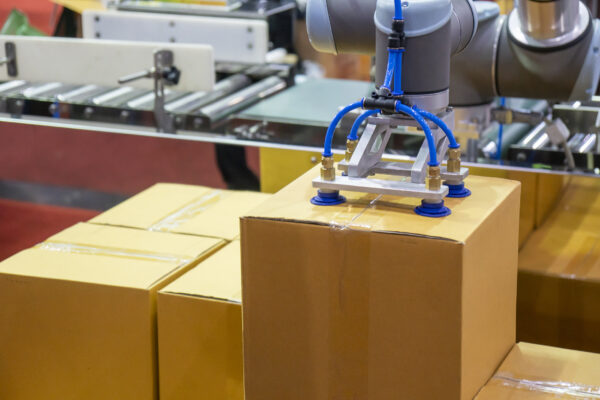 Dan Migliozzi
Dan Migliozzi What’s the future for piece-picking robots?
Piece-picking robotics is making big strides in the warehouse and with the aid of AI could soon be within the grasp of SMEs. Dan Migliozzi, Head of Sales at independent systems integrator, Invar Group, sets out where we are on the journey
What news can there possibly be around piece-picking robots? Arm finds item, picks it up, manipulates or orients it, puts it in the right place – end of. It’s the classic application of industrial robotics and has been so, at least on high volume production lines, for four decades.
But in a sense, that application is barely robotics at all – functionally, an old-fashioned juke box did much the same thing, and the machine typically can only work with one or a very limited set of items, presented to it in a very structured way. As early investors in robotics discovered to their cost, these ‘general purpose robots’ were in practice highly task-specific and although they have become essential in high volume production, they have been of limited utility in the warehouse and similar situations where the need is to pick from a very wide range of items varying in shape, size, robustness and orientation.
Now, however, and seemingly overnight – although in reality these developments have been years in the making – advances in sensors, vision systems, handling devices and the means of controlling them, including the beginnings of Machine Learning (ML) and Artificial Intelligence (AI), are making general purpose picking robots a practical reality. For Invar, as a leading independent systems integrator, this is becoming a very exciting space.
Presented with a mixed selection of items, the robot can now identify the correct piece, either by scanning a barcode or RFID signal, or purely by analysing the input from a vision system. Either way, algorithms can work out the current and required orientation. The robot can handle the piece according to parameters ‘attached’ to the identity of the piece, including what tool to use to pick the piece up, and how much force is appropriate – or in the case of increasingly popular manipulation by vacuum suckers, which elements from an array of suckers to use, and how much suction to apply. Using developing forms of ML/AI, the robot can be ‘trained’ to deal with novel items, and even optimise its own operations.
This is important for many industries and companies because up to now, piece part picking has tended to be highly labour-intensive and stubbornly resistant to automation. Many parts were awkwardly shaped, too fragile, too small or there was too large a range of sizes/weights. Also, they might require prior operations to present them in the right orientation for the robot or there may be quality issues which require pre-screening, and so on.
In these circumstances any return on investment in automation has often seemed nebulous, and manual labour has often been preferred. But now, not only is human labour scarce and increasingly expensive, manual pick rates may be slow by comparison with more advanced forms of automation, with high numbers of errors – often exacerbated by illness or fatigue. A business operating in, for example, direct to consumer pharmaceuticals, a growing field, cannot tolerate less than 100% accuracy. Similarly, there is no ‘acceptable’ level of damage to electronic components and this can’t be guaranteed with manual systems.
 However, the good news is, item picking technology is moving ahead at quite a pace and is fast becoming affordable to SMEs, with a reasonable ROI. So, as labour continues to be hard to find and costly, piece picking robots are likely to become more and more attractive, and when allied to the availability of highly scaleable Autonomous Mobile Robots (AMRs) can represent a significant de-risking of the business.
However, the good news is, item picking technology is moving ahead at quite a pace and is fast becoming affordable to SMEs, with a reasonable ROI. So, as labour continues to be hard to find and costly, piece picking robots are likely to become more and more attractive, and when allied to the availability of highly scaleable Autonomous Mobile Robots (AMRs) can represent a significant de-risking of the business.
There are a number of options as to how picking robots are deployed. Picking arms may be in fixed locations with goods reaching them on conveyors, AMRs, mobile racking, carousels or the like – and completed picks similarly removed. Or they may rove the warehouse floor mounted on AMRs. They may be designed as cobots, specifically to work safely alongside people, or they may be ‘fenced off’ – physically, or through software and safety features.
There is a further important point of consideration. As noted, previous piece-picking robots have often required goods to be presented in closely defined orientations. For example, so that the barcode can be scanned, or the shape recognised, or so that they don’t overlap. This can require either manual intervention or an array of handling devices that in sum may be as complex and expensive as the robot itself – they also take up a lot of space. It is increasingly likely that with advanced, AI-enabled vision and other systems, much or all of this preparation can be dispensed with.
Piece-picking robots are becoming far more dextrous, quick-learning and adaptive. But, of course, there is still a need to train the robots with the right images and algorithms. It’s fair to say that both suppliers and integrators are actively engaged in working out the most effective ways of organising this, but what is evident to us is that, at this stage in the development and adoption of the technology, there is a real need for open collaboration between all the travellers on this journey into robotic picking.
As independent integrators of advanced warehouse technology with a dedicated division of software developers, we are closely involved in the fast-evolving field of piece-picking robotics and in progressing the smooth interface between robots, controllers and warehouse management systems.









